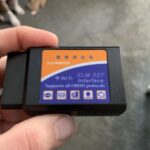For Honda S2000 enthusiasts, particularly those owning the 2006 and later models (often referred to as ’08 S2000 Obd2′ due to model year variations and OBD2 system differences), accessing and understanding vehicle data can unlock a new level of insight into your car’s performance and health. Modern vehicles, including the S2000, utilize a Controller Area Network (CAN) bus system for communication between various electronic control units (ECUs). This network carries a wealth of real-time data, from engine parameters to sensor readings, all accessible via the OBD2 port.
One of the most compelling uses of the OBD2 port and CAN bus is data logging. By tapping into the CAN network, you can record and analyze crucial data points, helping you to diagnose issues, optimize performance, and gain a deeper understanding of your S2000’s inner workings. This article explores the possibilities of accessing CAN bus data on your ’08 S2000 OBD2 system, drawing upon insights from dedicated enthusiasts who have ventured into this fascinating area.
Understanding Key Data Parameters on the S2000 CAN Bus
Enthusiasts have already begun to map out the data available on the Honda S2000 CAN bus. Through dedicated effort and analysis, valuable information regarding specific data parameters and their corresponding CAN identifiers (IDs) has been discovered. These IDs are essentially addresses that allow you to pinpoint and extract specific data streams from the CAN network.
Here are some key parameters that have been successfully logged from the S2000 CAN bus:
-
Throttle Position Sensor (TPS): This critical parameter reflects the position of your throttle pedal, indicating how much power you are demanding from the engine. The CAN ID for TPS on some S2000 models is 170, and it is typically represented in byte 1 of the data frame. The data stream operates at a high frequency, around 100 frames per second, ensuring real-time accuracy. To interpret the raw data into a percentage (0-100%), a formula is applied:
Raw x 100 / 255 + 0. -
Steering Angle: For performance analysis and chassis dynamics understanding, steering angle data is invaluable. The S2000 CAN bus broadcasts steering angle information at approximately 100 frames per second. The CAN ID for steering angle is 198, and it utilizes bytes 1 & 2. Steering angle is typically measured in degrees, with negative values indicating left turns and positive values for right turns. The formula to convert the raw data into degrees is:
Raw x 1 / 10 + 0. -
Engine Coolant Temperature: Monitoring engine coolant temperature is crucial for ensuring engine health and preventing overheating. This data is transmitted at around 100 frames per second with a CAN ID of 300, located in byte 1.
Exploring Brake Pressure Data and Potential Challenges
While significant progress has been made in accessing parameters like TPS, steering angle, and coolant temperature, some data points remain more challenging to decipher. One such parameter is brake pressure. Initial investigations suggest that brake pressure data might be located at CAN ID 106, specifically in byte 3. It is also believed to stream at a very high rate of approximately 150 frames per second.
However, successfully logging brake pressure data has proven to be more complex. Simply adjusting the byte offset to access byte 3 within the CAN ID 106 data frame may not yield the desired results. This could be due to various factors, including:
- Data Encoding: The brake pressure data might be encoded or formatted differently compared to other parameters. It could involve bitwise manipulation or a different scaling factor.
- CAN Bus Protocol Variations: Slight variations in the CAN bus protocol across different S2000 model years or even within the ’08 S2000 OBD2 range could affect data locations and interpretation.
- Data Encryption: While less likely for basic parameters, there’s a possibility that brake pressure data or related control signals might involve a degree of encryption, although this is less common for fundamental sensor data.
Accessing CAN Bus Data via the OBD2 Port
To tap into the CAN bus data on your ’08 S2000 OBD2, you’ll typically need a CAN interface device that connects to your car’s OBD2 port. These devices, often referred to as CAN dongles or adapters, bridge the gap between your car’s CAN network and your computer or data logging equipment.
One example of a tool mentioned by enthusiasts is a CANUSB dongle. These dongles, along with appropriate software, allow you to monitor and record CAN bus traffic. Software tools often provide features for filtering data based on CAN IDs, interpreting raw data based on defined formulas, and visualizing the data in real-time dashboards or for later analysis.
Contributing to S2000 CAN Bus Mapping
The journey of mapping the Honda S2000 CAN bus is an ongoing collaborative effort within the car enthusiast community. Sharing findings, experiments, and insights is crucial for expanding our collective knowledge. If you are working on accessing CAN data on your ’08 S2000 OBD2, consider contributing your discoveries. This could involve:
- Sharing Successfully Logged Parameters: If you’ve identified CAN IDs and data formats for parameters not yet documented, share your findings with the community.
- Investigating Unresolved Data Points: Tackling challenging parameters like brake pressure and sharing your attempts and results can help others build upon your work.
- Developing and Sharing Tools/Scripts: Creating software scripts or configurations for specific CAN dongles or data logging software tailored to the S2000 can greatly benefit other enthusiasts.
By working together and sharing information, the S2000 community can continue to unlock the full potential of the ’08 S2000 OBD2 system and gain unprecedented access to valuable vehicle data for performance enhancement, diagnostics, and a deeper connection with their beloved machines.
